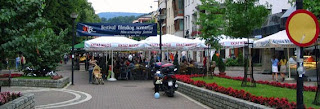In the rolling hills of Central Serbia sits the idyllic spa town of Vrnjčka spa, harmoniousliy balanced in it's beatiful natural surrounding. Vrnjačka spa is located 200km south of Belgrade, set amongst the foothills of Goč mountain to the south, east and west, and the Gledićke mountain range to the north. Besides Goč (1147m) and Kopaonik (2017m), there are also the mountains of Željin (1785m), Jastrebac (1492m) and Stolovi (1375m). The mountain area of Vrnjačka spa is interlaced with green meadows and mountain streams that lead into the Zapadna Morava river. The rivers of Ibar on the west and Rasina to the east surround the spa's idyllic setting.
First established as a tourist spa in 1868, Vrnjačka spa has long been known as one of Serbia's most popular European-styled spa's, complete with curative mineral water springs, clean air and natural beauty. It's stunning location provides a unique microclimate, which las led to development of lush landscaped grounds that provide an oasis of tranquility and beauty for guests to enjoy and relax.
It owes it's reputation to therapeutic effects known already to the Roman troops in the 2nd century AD. It was upgraded by the Czech Baron Herder in 1835 after prince Miloš Obrenović wanted to be like Karlovy Vary, it has since received people from all of Southern Europe, who came to rest or for treatment. Summers are pleasant, and the winter is mild. With organized walks along the tree bordered paths, Vrnjačka spa is an ideal place to come to for one's own salvation. Natural springs can be found on five mineral water sources well positioned in the park. The warm water (36 degrees Celsius) is ideal for massage, and cool (17 degrees Celsius) sufficiently reviving.
There are seven mineral springs in Vrnjačka spa, from which first four are used for medical treatment:
- Topla voda (36.5 degrees Celsius)
- Snežnik (17 degrees Celsius)
- Slatina (24 degrees Celsius)
- Jezero (27 degrees Celsius)
- Beli izvor
- Borjak
- Vrnjačko vrelo
The hotels are numerous and have swimming pools and halls for games. In winter, it is convenient for skiing on the Goč, just a few kilometers away. In the summer, Vrnjačka spa is transformed into one of greatest cultural centres in Serbia: literary soirees in a very nice library of the moders style, classical concerts under the column capitals and the festival of cinema scenario. The restauranst are often on the border of a water current and offer terraces under the trees of the park.
The largest opanak in the world, in the Guinness World Records since 2006, is the 3.2m shoe, size 450, weighing 222kg (489lb), made by opančar Slavko Strugarević, is on the next picture.
One of the famous landmarks of Vrnjačka spa is the Bridge of love.
" At the dawn of the First World War, while the war was not even suspected yet, a schoolmistress Nada and a Serbian officer Relja started having deep feelings for each other. They fell in love and made a commitment to each other. It was a love widely talked about, attracting the attention of all the people living at Vrnjačka spa. But the war did break out with all the horrors it entails. Relja went off to war fought in Greece. He left never to return on account of a beautiful Greek woman he had fallen in love with, and therefore broke up the engagement to Nada. The legend does not say anything about his further fate, whereas, on the other hand, every inhabitant of Vrnjačka spa is familiar with Nada's destiny. Owing to overwhelming sorrow she faded away day after day and finally died, young and miserable. Upset by Nada's destiny, girls, wishing to keep their own romances, started writing down their names along with the names of their lovers on padlocks that they bound to the railing of the bridge which used to be the favorite meeting place of Nada and Relja. Afterward the keys were symbolically thrown into the river. New wars and sufferings came up. The story fell into oblivion, and the girl's custom to "bind" their love became uncustomary. It had been case until Desanka Maksimović,according to the stories of old residents of Vrnjacka Banja spa, became acquainted with this tragic story. Inspired by it she wrote down one of her most beautiful love poems "A Prayer for Love", (Molitva za ljubav). Although we tend to forget things, this story remains to be unforgotten, and in order to prolong its existence the young couples kept on with the tradition of "binding" their love and it bridge itself got the name "THE BRIDGE OF LOVE". "










Znate li jad je objavljena pesma >>MOlitva za ljubav<<?
ОдговориИзбриши